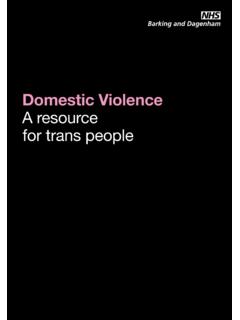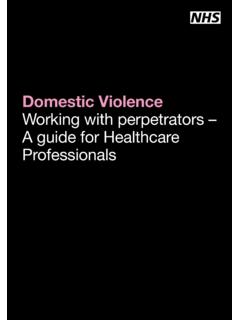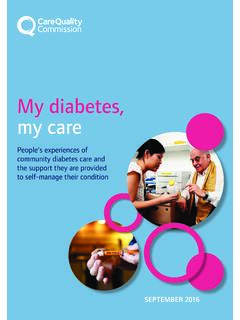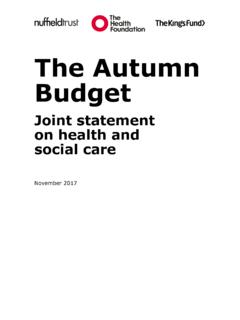Transcription of Responding to domestic abuse - London
1 Responding todomestic abuse : a handbook for health professionalsResponding todomestic abuse : a handbook for health professionalsDH INFORMATION READER BOXP olicyEstatesHR / WorkforcePerformanceManagementIM & TPlanningFinanceClinicalPartnership WorkingDocument PurposeBest Practice GuidanceROCR Ref:Gateway Ref: 5802 TitleResponding to domestic abuse : a handbook for healthprofessionalsAuthorDepartment of HealthPublication DateDecember 2005 Target AudiencePCT CEs, NHS Trust CEs, SHA CEs, Care Trust CEs, MedicalDirectors, Directors of PH, Directors of Nursing, PCT PEC Chairs,Allied Health Professionals, GPs, Emergency Care LeadsCirculation ListFoundation Trust CEs, Directors of HR, Allied HealthProfessionals, Communications Leads, Voluntary OrganisationsDescriptionResponding to domestic abuse : a handbook for healthprofessionals supersedes domestic Violence: A Resource Manualfor Health Care Professionals (March 2000).
2 The revisedhandbook gives practical guidance to healthcare professionalson working with service users who have experienced or areexperiencing domestic abuse . The domestic abuse andPregnancy Advisory Group, which had representation from theDepartment of Health, and included the relevant Royal Collegesand domestic violence voluntary organisations, provided adviceto Health Ministers on the Children s NSF Recommendation onthe need to provide a supportive and enabling environmentwithin antenatal care for women to disclose domestic violenceCross RefN/ASuperseded DocsDomestic Violence: A Resource Manual for Health CareProfessionalsAction RequiredN/ATimingN/AContact DetailsPatricia ParrisDepartment of HealthRoom 212 Wellington House133 155 Waterloo RoadLondon SE1 8 UGFor Recipient s UseContentsForeword from Caroline Flint.
3 MPParliamentary Under Secretary of State for Public Health v1 Using the handbook12 domestic abuse is a health issue 93 Guidance for health professionals 354 Guidance for policy-makers and managers83 Annexes 107 Annex A Membership of the Inter-Ministerial Groupon domestic Violence107 Annex B Action plan drawn up in response to therecommendations of the domestic Abuseand Pregnancy Advisory Group108 Annex C Women with particular needs112 Annex D Sample safety plan120 Annex E Sample risk assessment123 Useful contacts127 Local information1441. Electronic text of the handbook2. Sample domestic violence strategy, policy and practice guidelines3. Guidance for Partnerships and Primary Care Trusts (PCTs)Contents of CD-RomEven though much domesticabuse occurs within the privacyof personal relationships, it s farfrom being a private in all parts of society,it accounts for a quarter of allviolent crime and costs thetaxpayer billions of poundsevery year billion inEngland and Wales in the greatest cost is to thewomen and children from allsocial backgrounds who dealwith its effects on their lives ona day-to-day basis, even longafter they have escaped extent of the problem isshocking and intolerable.
4 TheGovernment has responded bymaking it a priority to:> bring to justice perpetratorsof domestic abuse ;> support women and childrenwho experience abuse ; and> prevent future cases ofdomestic Inter-Ministerial Group onDomestic Violence implementsnational strategy and issupported by legislation (suchas the domestic Violence,Crime and Victims Act 2004)that strikes at the heart ofthe strategy and legislationalone don t guarantee relies on a multi-agencyapproach, so that everybodyplays their part in helpingwomen and children createsafer lives for themselves. TheNHS has an important role notonly because healthprofessionals deal with injuriescaused by domestic violence intheir daily work, but alsobecause they are often awoman s first or only contactForewordwith a professional who couldprovide a lifeline to health sector is alreadymaking a significantcontribution:> The Crime and Disorder Act1998 gave Primary CareTrusts a statutory duty towork within Crime andDisorder ReductionPartnerships to reduce localcrime including domesticviolence.
5 > In collaboration with theNational Institute for MentalHealth in England, theDepartment of Health (DH)has established a substantialprogramme of work for2004/05 and beyond toalleviate the health andmental health effects ofdomestic violence on womenand children.> Recognising that many casesof domestic abuse startduring pregnancy, DH set upthe domestic abuse andPregnancy Advisory Group in2005. Its recommendationson how health services couldmeet the needs of pregnantwomen who areexperiencing abuse haveinformed this handbook andwill help shape future policy.> domestic abuse has been animportant consideration inhealth consultations,inquiries (Why mothers die,2000 02 (ConfidentialEnquiry into Maternal andChild Health 2004)) andWhite Papers (the publichealth White Paper 2004 andthe new Your health, yourcare, your say, 2005).
6 Responding to domestic abuseviThe Government has anevidence base for the work it istaking forward to respond todomestic abuse . The CrimeReduction Programme sViolence Against WomenInitiative was an evidence-ledprogramme that aimed to findout which approaches andpractices were effective insupporting survivors ofdomestic and sexual abuseand in reducing incidents ofabuse. Five multi-agency,victim-focused projects werebased within health contextssuch as primary care and A& aimed to encourage andsupport disclosure of domesticabuse and facilitate entry intospecialist domestic violencesupport services, and everyproject underwent independent evaluation wasalso undertaken on a pilotproject implemented by theUniversity of the West ofEngland and North Bristol NHST rust, which aimed to equipcommunity midwives to enquireeffectively about domestic abuseduring pregnancy.
7 It was foundthat introducing enquiry aboutdomestic abuse significantlyopened up opportunities forwomen to talk about theirexperiences of abuse duringpregnancy and led to anincrease in the numbers ofwomen disclosing old andnew to domestic abuse :a handbook for professionalsisa practical tool that answers thequestion What am I supposedto do if one of my patients tellsme they re experiencingdomestic abuse ? It takes onA handbook for health professionalsviiboard feedback from users ofDomestic violence: a resourcemanual for health careprofessionals, which waspublished in 2000, and hasbeen designed to be easy touse, functional and builds on good practice that isalready in place across thecountry and will enable healthprofessionals to respondconsistently to domestic training manual thataccompanies this publicationcan be found on DH s CD-Rom contains anelectronic version of the manualand key papers with handbook takes a nationalvision and puts it into well as helping frontline staffrecognise and give appropriatesupport to women and childrenwho are being abused, it willpromote networking andinformation-sharing amongstdomestic violence such, it is an importantstepping stone towards aneffective.
8 Multi-agencyresponse to domestic abusethat will create safer futuresand better health for thousandsof women and children andfor society as a Flint, MPParliamentary Under Secretaryof State for Public HealthMember of the Inter-MinisterialGroup on domestic ViolenceResponding to domestic abuseviii1 Using the handbook Using the handbookSection 1In this Contents Target audience Responding to domestic abuse : a handbook for health professionals How to use the handbookA useful reference toolThis handbook gives practicalguidance to healthcareprofessionals on working withpatients who may haveexperienced or are experiencingdomestic abuse . It provides:>all readers with an insightinto domestic abuse and itseffects on individuals, thehealth service and society;>healthcare professionals withpractical prompts that theywill be able to use in theirday-to-day work withwomen and children; and>managers and policy-makerswith advice on creatingstrategies for improving thecare given to those who haveexperienced or areexperiencing domestic well as covering work withwomen, the handbook coversthe basic information thathealthcare professionals willneed to know to respondeffectively to children who haveexperienced or are experiencingdomestic s contribution tonational initiativesDomestic abuse is a priorityacross government.
9 Dealingwith its effects and trying toalleviate the problem require amulti-agency approach noone organisation has all theanswers. But by workingtogether, central and localgovernment, criminal justiceagencies, voluntary sectororganisations and the NHS havea greater chance of meetingwomen and children s April 2004, Primary CareTrusts have had a statutory dutyto work with other localagencies to reduce crime (inCrime and Disorder ReductionPartnerships under the Crimeand Disorder Act 1998). domestic violence forms aquarter of all violent crime, soby following the guidance inthis handbook, staff are helpingthe NHS to fulfil its handbook is also aresponse to the domestic Abuseand Pregnancy Advisory Grouprecommendations, August2005, which we haveincorporated into an action plan(see Annex B).
10 The action plansets out how national maternityservices can create a supportiveenvironment for women whomay have experienced domesticabuse most importantly byroutinely asking if a woman isexperiencing abuse andproviding information (oncestaff have received appropriatetraining). The plan is relevant tohealth services in general and ithas informed many of thepractical prompts in response to genuine needThe handbook gives very clearanswers to questions that manyhealthcare professionals havebeen asking: What s my role? , What am I supposed to do? or Should I tell a woman whosepartner has hit her to leave? Thankfully, although domesticabuse is a complicated issue, ourresponse doesn t have to guidance in this handbooksets out clearly what is expectedof us to domestic abuse2 Target who works for theNHS from administrative staffto clinical staff.











